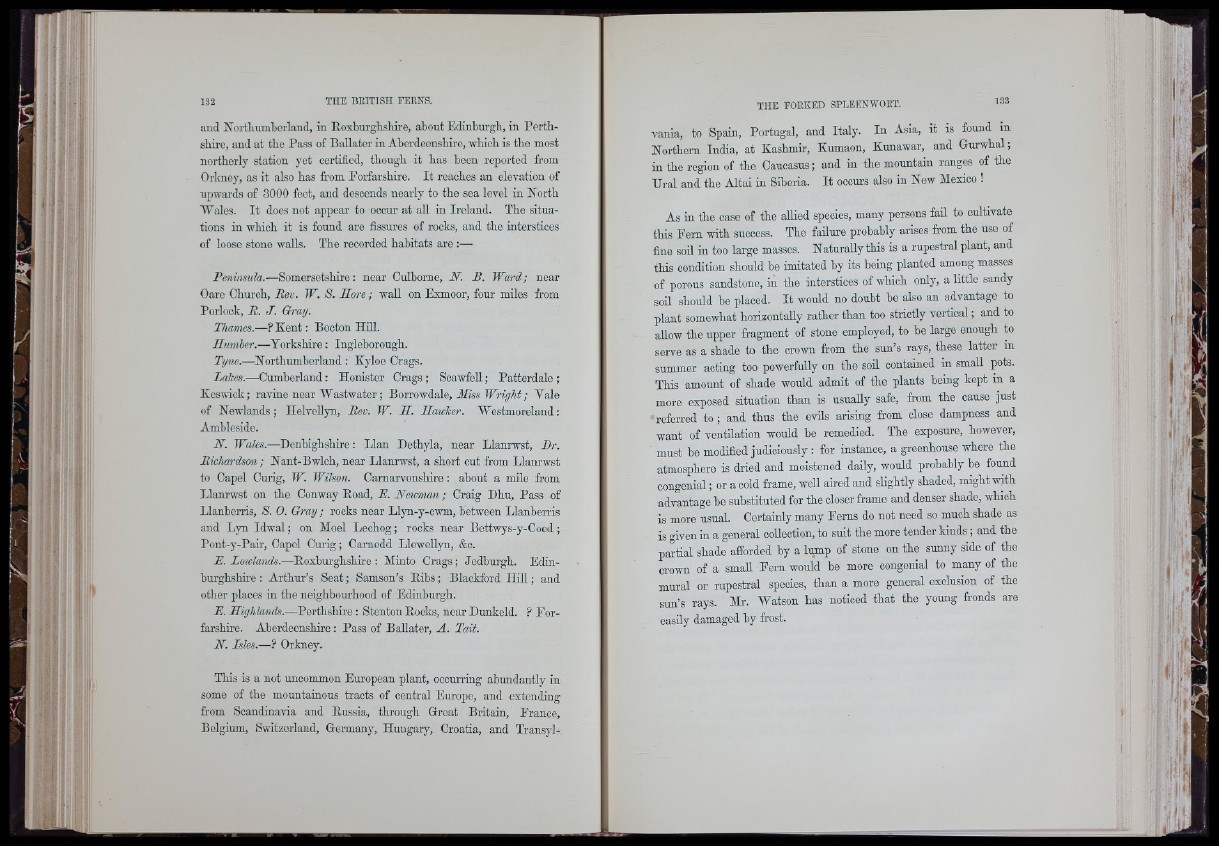
' ■
i :
I ;
i
ri.
t i-,
¡■•'7
and Nortlmmberland, in Eoxburghsliire, about Edinburgh, in Perthshire,
and at tho Pass of Ballater in Aberdeenshire, which is the most
northerly station yot certified, though it has boon reported from
Orkney, as it also has from Forfarshire. It reaches an elevation of
upwards of 3000 foot, and descends nearly to tho sea level in North
Wales. It does not appear to occur at aU in Ireland. The situations
in which it is found are fissures of rocks, and tho interstices
of loose stone walls. The recorded habitats aro :—-
Peninsula.—Somersetshire: near Culborne, N. B. Ward; near
Oaro Church, JReih W. S. Hore; waU on Exmoor, four miles from
Porlook, R. J. Gray.
Thames.—? K ent; Bocton HUl.
Humber.—Yorkshire : Ingleborough.
Tyne.—Northumberland : Kyloe Crags.
Lakes.—Cumberland: Honister Crags ; Scawfell; Patterdale ;
Keswick; ravine near Wastwater; Borrowdale, Miss Wright; Vale
of Newlands; IlelvoUyn, Rev. W. H. Hawker. Westmoreland:
Ambleside.
N. Wales.—Denbighshire: Llan Dethyla, near Llanrwst, Br.
Richardson; Nant-Bwloh, near Llanrwst, a short cut from Llanrwst
to Capel Curig, W. Wilson. Carnarvonshire : about a mile from
Llanrwst on the Conway Hoad, E. Neicman; Craig Dhu, Pass of
Llanberris, S. 0. Gray; rooks near Llyn-y-cwm, between Llanberris
and Lyn Idwal; on Moel Leohog; rocks near Bettwys-y-Cood ;
Bont-y-Pair, Capol Curig; Carnodd Llewellyn, &c.
E. Lowlands.—Roxburghshire : Minto Crags; Jedburgh. Edinburghshire
: Arthur’s Seat; Samson’s Ribs; Blackford H ill; and
other places in the neighbom’hood of Edinburgh.
E. Highlands.—Perthshire : Stenton Rooks, near Dunljeld. P Forfarshire.
Aberdeenshire: Pass of BaUater, A. Tait.
N. Isles.—? Orkney.
This is a not uncommon European plant, occurring abundantly in
some of tbe mountainous tracts of central Europe, and extending
from Scandinavia and Russia, through Great Britain, France,
Belgium, Switzerland, Germany, Hungary, Croatia, and Transylvania,
to Spain, Portugal, and Italy. In Asia, it is found in
Northern India, at Kashmir, Kumaon, Kunawar, and Gurwhal;
in the region of the Caucasus ; and in the mountain ranges of the
Ural and the Altai in Siberia. It occurs also in New Mexico !
As in the case of the allied species, many persons fail to cultivate
this Fern with success. The failure probably arises from tbe use of
fine soil in too large masses. Naturally this is a rupestral plant, and
this condition should be imitated by its being planted among masses
of porous sandstone, in tbe interstioes of which only, a little sandy
soil should be placed. It would no doubt be also an advantage to
plant somowbat horizontally rather than too strictly vertical ; and to
allow the upper fragment of stone employed, to be largo enough to
serve as a shade to the crown from the sun’s rays, these latter in
summer acting too powerfully on the soil contained in small pots.
This amount of shade would admit of the plants bemg kept m a
more exposed situation than is usuaUy safe, from the cause just
referred to ; and thus the evils arising from close dampness and
want of ventUation would be remedied. The exposure, however,
must be modified judiciously : for instance, a greenhouse where the
atmosphere is dried and moistened daUy, would probably be found
congenial ; or a cold frame, well aired and sUghtly shaded, might with
advantage be substituted for the closer frame and denser shade, which
is more usual. Certainly many Ferns do not need so much shade as
is given in a general coUeotion, to suit the more tender kinds ; and the
partial shade afforded by a lump of stone on the sunny side of the
crown of a smaU Fern would be more congenial to many of the
mural or rupestral species, than a more general exclusion of the
sun’s rays. Mr. Watson has noticed that the young fronds are
easily damaged by frost.
• J ■
i
1 . 1
I 'H
(.■•■I
■( :
- é r \
i
I :J
j if
' .V
]
4 1
<!l‘î